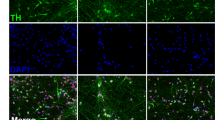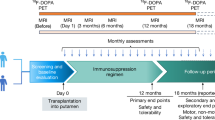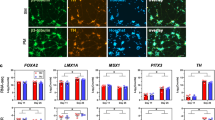Abstract
Human embryonic stem cells (hESCs) can proliferate indefinitely yet also differentiate in vitro, allowing normal human neurons to be generated in unlimited numbers. Here, we describe the development of an in vitro neurotoxicity assay using human dopaminergic neurons derived from hESCs. We showed that the dopaminergic neurotoxin 1-methyl-4-phenylpyridinium (MPP+), which produces features of Parkinson's disease in humans, was toxic for hESC-derived dopaminergic neurons. Treatment with glial cell line-derived neurotrophic factor protected tyrosine hydroxylase-positive neurons against MPP+-induced apoptotic cell death and loss of neuronal processes as well as against the formation of intracellular reactive oxygen species. The availability of human dopaminergic neurons, derived from hESCs, therefore allows for the possibility of directly examining the unique features of human dopaminergic neurons with respect to their responses to pharmacological agents as well as environmental and chemical toxins.
Similar content being viewed by others
Log in or create a free account to read this content
Gain free access to this article, as well as selected content from this journal and more on nature.com
or
References
Akerud P, Canals JM, Snyder EY, Arenas E (2001). Neuroprotection through delivery of glial cell line-derived neurotrophic factor by neural stem cells in a mouse model of Parkinson's disease. J Neurosci 21: 8108–8118.
Betarbet R, Sherer TB, MacKenzie G, Garcia-Osuna M, Panov AV, Greenamyre JT (2000). Chronic systemic pesticide exposure reproduces features of Parkinson's disease. Nat Neurosci 3: 1301–1306.
Biedler JL, Helson L, Spengler BA (1973). Morphology and growth, tumorigenicity, and cytogenetics of human neuroblastoma cells in continuous culture. Cancer Res 33: 2643–2652.
Block ML, Wu X, Pei Z, Li G, Wang T, Qin L et al (2004). Nanometer size diesel exhaust particles are selectively toxic to dopaminergic neurons: the role of microglia, phagocytosis, and NADPH oxidase. FASEB J 18: 1618–1620.
Brimble SN, Zeng X, Weiler DA, Luo Y, Liu Y, Lyons IG et al (2004). Karyotypic stability, genotyping, differentiation, feeder-free maintenance, and gene expression sampling in three human embryonic stem cell lines derived prior to August 9, 2001. Stem Cells Dev 13: 585–597.
Burns RS, Chiueh CC, Markey SP, Ebert MH, Jacobowitz DM, Kopin IJ (1983). A primate model of Parkinsonism-selective destruction of dopaminergic-neurons in the pars compacta of the substantia nigra by N-methyl-4-phenyl-1,2,3,6-tetrahydropyridine. Proc Natl Acad Sci USA 80: 4546–4550.
Buytaert-Hoefen KA, Alvarez E, Freed CR (2004). Generation of tyrosine hydroxylase positive neurons from human embryonic stem cells after coculture with cellular substrates and exposure to GDNF. Stem Cells 22: 669–674.
Cadet JL, Brannock C (1998). Free radicals and the pathobiology of brain dopamine systems. Neurochem Int 32: 117–131.
Carvey PM, Chang Q, Lipton JW, Ling Z (2003). Prenatal exposure to the bacteriotoxin lipopolysaccharide leads to long-term losses of dopamine neurons in offspring: a potential, new model of Parkinson's disease. Front Biosci 8: S826–S837.
Clarkson ED, Zawada WM, Freed CR (1997). GDNF improves survival and reduces apoptosis in human embryonic dopaminergic neurons in vitro. Cell Tissue Res 289: 207–210.
D'Amato RJ, Alexander GM, Schwartzman RJ, Kitt CA, Price DL, Snyder SH (1987). Evidence for neuromelanin involvement in MPTP-induced neurotoxicity. Nature 327: 324–326.
Davis GC, Williams AC, Markey SP, Ebert MH, Caine ED, Reichert CM et al (1979). Chronic Parkinsonism secondary to intravenous injection of meperidine analogues. Psychiatry Res 1: 249–254.
Di Monte DA (2003). The environment and Parkinson's disease: is the nigrostriatal system preferentially targeted by neurotoxins? Lancet Neurol 2: 531–538.
Di Monte DA, Lavasani M, Manning-Bog AB (2002). Environmental factors in Parkinson's disease. Neurotoxicology 23: 487–502.
Gash DM, Gerhardt GA, Hoffer BJ (1998). Effects of glial cell line-derived neurotrophic factor on the nigrostriatal dopamine system in rodents and non-human primates. Adv Pharmacol 42: 911–915.
Gayle DA, Ling Z, Tong C, Landers T, Lipton JW, Carvey PM (2002). Lipopolysaccharide (LPS)-induced dopamine cell loss in culture: roles of tumor necrosis factor-alpha, interleukin-1beta, and nitric oxide. Brain Res Dev Brain Res 133: 27–35.
Giovanni A, Sonsalla PK, Heikkila RE (1994). Studies on species sensitivity to the dopaminergic neurotoxin 1-methyl-4-phenyl-1,2,3,6-tetrahydropyridine. Part 2: central administration of 1-methyl-4-phenylpyridinium. J Pharmacol Exp Ther 270: 1008–1014.
Granholm AC, Reyland M, Albeck D, Sanders L, Gerhardt G, Hoernig G et al (2000). Glial cell line-derived neurotrophic factor is essential for postnatal survival of midbrain dopamine neurons. J Neurosci 20: 3182–3190.
Greene LA, Tischler AS (1976). Establishment of a noradrenergic clonal line of rat adrenal pheochromocytoma cells which respond to nerve growth factor. Proc Natl Acad Sci USA 73: 2424–2428.
Irie F, Hirabayashi Y (1999). Ceramide prevents motoneuronal cell death through inhibition of oxidative signal. Neurosci Res 35: 135–144.
Johannessen JN, Chiueh CC, Burns RS, Markey SP (1985). Differences in the metabolism of MPTP in the rodent and primate parallel differences in sensitivity to its neurotoxic effects. Life Sci 36: 219–224.
Kalaria RN, Harik SI (1986). Nucleoside transporter of cerebral microvessels and choroid plexus. J Neurochem 47: 1849–1856.
Kalaria RN, Harik SI (1987). Blood–brain barrier monoamine oxidase: enzyme characterization in cerebral microvessels and other tissues from six mammaliam species, including human. J Neurochem 49: 856–864.
Kalaria RN, Mitchell MJ, Harik SI (1987). Correlation of 1-methyl-4-phenyl-1,2,3,6-tetrahydropyridine neurotoxicity with blood–brain barrier monoamine oxidase activity. Proc Natl Acad Sci USA 84: 3521–3525.
Langston JW, Ballard P, Tetrud JW, Irwin I (1983). Chronic Parkinsonism in humans due to a product of meperidine-analog synthesis. Science 219: 979–980.
Lesch KP, Gross J, Wolozin BL, Murphy DL, Riederer P (1993). Extensive sequence divergence between the human and rat brain vesicular monoamine transporter: possible molecular basis for species differences in the susceptibility to MPP+. J Neural Transm Gen Sect 93: 75–82.
Lin LF, Doherty DH, Lile JD, Bektesh S, Collins F (1993). GDNF: a glial cell line-derived neurotrophic factor for midbrain dopaminergic neurons. Science 260: 1130–1132.
Misiuta IE, Anderson L, McGrogan MP, Sanberg PR, Willing AE, Zigova T (2003). The transcription factor Nurr1 in human NT2 cells and hNT neurons. Brain Res Mol Brain Res 145: 107–115.
Mitsuhata C, Kitayama S, Morita K, Vandenbergh D, Uhl GR, Dohi T (1998). Tyrosine-533 of rat dopamine transporter: involvement in interactions with 1-methyl-4-phenylpyridinium and cocaine. Brain Res Mol Brain Res 56: 84–88.
Park TH, Kwon OS, Park SY, Han ES, Lee CS (2003). N-methylated beta-carbolines protect PC12 cells from cytotoxic effect of MPP+ by attenuation of mitochondrial membrane permeability change. Neurosci Res 46: 349–358.
Perrier AL, Tabar V, Barberi T, Rubio ME, Bruses J, Topf N et al (2004). Derivation of midbrain dopamine neurons from human embryonic stem cells. Proc Natl Acad Sci USA 101: 12543–12548.
Porrino LJ, Burns RS, Crane AM, Palombo E, Kopin IJ, Sokoloff L (1987). Local cerebral metabolic effects of L-dopa therapy in 1-methyl-4-phenyl-1,2,3,6-tetrahydropyridine-induced Parkinsonism in monkeys. Proc Natl Acad Sci USA 84: 5995–5999.
Riachi NJ, Harik SI (1988). Strain differences in systemic 1-methyl-4-phenyl-1,2,3,6-tetrahydropyridine neurotoxicity in mice correlate best with monoamine oxidase activity at the blood-brain barrier. Life Sci 42: 2359–2363.
Roussa E, Krieglstein K (2004). GDNF promotes neuronal differentiation and dopaminergic development of mouse mesencephalic neurospheres. Neurosci Lett 361: 52–55.
Schwartz CM, Spivak CE, Baker SC, McDaniel TK, Loring JF, Nguyen C et al (2005). NTera2: a model system to study dopaminergic differentiation of human embryonic stem cells. Stem Cells Dev 14: 517–534.
Son JH, Chun HS, Joh TH, Cho S, Conti B, Lee JW (1999). Neuroprotection and neuronal differentiation studies using substantia nigra dopaminergic cells derived from transgenic mouse embryos. J Neurosci 19: 10–20.
Staal RG, Hogan KA, Liang CL, German DC, Sonsalla PK (2000). In vitro studies of striatal vesicles containing the vesicular monoamine transporter (VMAT2): rat versus mouse differences in sequestration of 1-methyl-4-phenylpyridinium. J Pharmacol Exp Ther 293: 329–335.
Tanner CM, Ottman R, Goldman SM, Ellenberg J, Chan P, Mayeux R et al (1999). Parkinson disease in twins: an etiologic study. JAMA 281: 341–346.
Teismann P, Tieu K, Cohen O, Choi DK, Wu DC, Marks D et al (2003). Pathogenic role of glial cells in Parkinson's disease. Mov Disord 18: 121–129.
Thiruchelvam M, Richfield EK, Baggs RB, Tank AW, Cory-Slechta DA (2000). The nigrostriatal dopaminergic system as a preferential target of repeated exposures to combined paraquat and maneb: implications for Parkinson's disease. J Neurosci 20: 9207–9214.
Thomson JA, Itskovitz-Eldor J, Shapiro SS, Waknitz MA, Swiergiel JJ, Marshall VS et al (1998). Embryonic stem cell lines derived from human blastocysts. Science 282: 1145–1147.
Tomac A, Lindqvist E, Lin LF, Ogren SO, Young D, Hoffer BJ et al (1995). Protection and repair of the nigrostriatal dopaminergic system by GDNF in vivo. Nature 373: 335–339.
Wang JY, Wu JN, Cherng TL, Hoffer BJ, Chen HH, Borlongan CV et al (2001). Vitamin D(3) attenuates 6-hydroxydopamine-induced neurotoxicity in rats. Brain Res 904: 67–75.
Yamasoba T, Schacht J, Shoji F, Miller JM (1999). Attenuation of cochlear damage from noise trauma by an iron chelator, a free radical scavenger and glial cell line-derived neurotrophic factor in vivo. Brain Res 815: 317–325.
Yamazoe H, Murakami Y, Mizuseki K, Sasai Y, Iwata H (2005). Collection of neural inducing factors from PA6 cells using heparin solution and their immobilization on plastic culture dishes for the induction of neurons from embryonic stem cells. Biomaterials 26: 5746–5754.
Yan Y, Yang D, Zarnowska ED, Du Z, Werbel B, Valliere C et al (2005). Directed differentiation of dopaminergic neuronal subtypes from human embryonic stem cells. Stem Cells 23: 781–790.
Zeng X, Cai J, Chen J, Luo Y, You ZB, Fotter E et al (2004a). Dopaminergic differentiation of human embryonic stem cells. Stem Cells 22: 925–940.
Zeng X, Chen J, Sanchez JF, Coggiano M, Dillon-Carter O, Petersen J et al (2003). Stable expression of hrGFP by mouse embryonic stem cells: promoter activity in the undifferentiated state and during dopaminergic neural differentiation. Stem Cells 21: 647–653.
Zeng X, Miura T, Luo Y, Bhattacharya B, Condie B, Chen J et al (2004b). Properties of pluripotent human embryonic stem cells BG01 and BG02. Stem Cells 22: 292–312.
Zhang Z, Miyoshi Y, Lapchak PA, Collins F, Hilt D, Lebel C et al (1997). Dose response to intraventricular glial cell line-derived neurotrophic factor administration in parkinsonian monkeys. J Pharmacol Exp Ther 282: 1396–1401.
Acknowledgements
This research was supported by the IRP of NIDA, NIDA, and DHHS.
Author information
Authors and Affiliations
Corresponding author
Additional information
Supplementary Information accompanies the paper on the Neuropsychopharmacology website (http://www.nature.com/npp)
Supplementary information
Rights and permissions
About this article
Cite this article
Zeng, X., Chen, J., Deng, X. et al. An In Vitro Model of Human Dopaminergic Neurons Derived from Embryonic Stem Cells: MPP+ Toxicity and GDNF Neuroprotection. Neuropsychopharmacol 31, 2708–2715 (2006). https://doi.org/10.1038/sj.npp.1301125
Received:
Revised:
Accepted:
Published:
Issue date:
DOI: https://doi.org/10.1038/sj.npp.1301125
Keywords
This article is cited by
-
In vitro acute and developmental neurotoxicity screening: an overview of cellular platforms and high-throughput technical possibilities
Archives of Toxicology (2017)
-
CYP3A5 Mediates Effects of Cocaine on Human Neocorticogenesis: Studies using an In Vitro 3D Self-Organized hPSC Model with a Single Cortex-Like Unit
Neuropsychopharmacology (2017)
-
Current Neurogenic and Neuroprotective Strategies to Prevent and Treat Neurodegenerative and Neuropsychiatric Disorders
NeuroMolecular Medicine (2015)
-
Present state and future perspectives of using pluripotent stem cells in toxicology research
Archives of Toxicology (2011)
-
Human Embryonic Stem Cell-Derived Neurons as a Tool for Studying Neuroprotection and Neurodegeneration
Molecular Neurobiology (2010)



